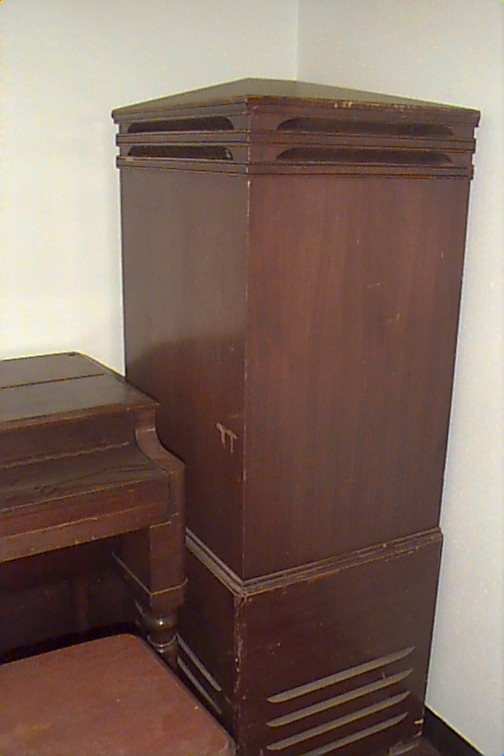From VintageOrgans.com

Hammond Model "A", Serial # 112 Autographed by Gaylord Carter


This organ is SOLD but we have others
Our Home Page lists the Available Inventory
Now here is an interesting piece that we haven't had time to fool around with yet. These photos show it straight off the truck as it came in. We can do it however you want it, . This A is Serial Number 112, and autographed in the bench by Gaylord Carter These are raw pictures of how she is right now, with a little elbow grease and a small amount of tlc this one will run like a top. It has a wonderful history. Here is the history as told by the previous owner: To: Vintage Hammond: The inscription on the console as I remember reads "To Ralph: Enjoy! Gaylord Carter" and the dates are either 1974 or 1984. And here's the story on the "Valee/Carter" Hammond Model "A". It was originally purchased new by "crooner" Rudy Valee. Remember that when of all of his work after the silent movie era came to a close with the major motion picture studios, Gaylord Carter had established lifetime friendships with people like Tiomkin, Korngold, etc.etc. He lived in Los Angeles, worked in studio orchestras and played organ and piano in film scoring. The Hammond "electric organ" was at that time a fascination for many of the big names in music as well, and Rudy's was one of the first one that other celebs got to "play with". Not long after that particular Hammond instrument was built, Hammond Organ/Clock Co. like many others changed production from Clocks/Musical Instruments over to the War effort. Gaylord BADLY needed a Hammond to use for Radio Soap Operas, and there were none available. Gaylord also wanted to do his part in the War Effort by entertaining at the USO in Hollywood. Without an organ this would have been less than a pleasure for Gaylord Carter! He played piano well, but it was NOT his bag! Rudy Valee had been on one of the sets and had mentioned that he had purchased one of the "new" Hammond electric organs prior to the conversion to the war effort. Valee, like many others was working, and on "Bond Tours" selling War Bonds at the time and after a great deal of pressure was applied by Gaylord, (your basic begging and pleading) Valee sold Gaylord Carter the Hammond. That instrument was one of Gaylord's most prized posessions during the War. It traveled and was bounced from location to location doing 78rpm records (There are a number of them with Gaylord performing on THAT particular Hammond out there in collectable record shops.) It did radio soap operas at the studios here in Los Angeles, it did backup for Armed Forces Radio. It became Gaylords "bread and butter". After World War II we had the advent of television. Gaylord bounced around the country, but became heavily involved with this new medium. Gaylord and that organ did a number of TV Soaps and also some of the early "game shows". In the early days of Los Angeles television, there were four organists that were in constant demand. Ivan Ditmars, Johnny Duffy, Fernand Martel and the most in demand was Gaylord! As electric/electronic organ production resumed, and they again became plentiful a number of the studios purchased organs and added the Leslie Speakers. When Gaylord didn't have to be "have organ will travel" the "Model A" initially went into his home on the Palos Verdes Peninsula overlooking the Pacific Ocean in Los Angeles. In the area of about 1955, Gaylord, always an expert at "re-inventing" himself started "Flicker Fingers Productions" promoting the lost art of silent film "cuing" and this somehow managed to get him a Los Angeles television show on an independent Los Angeles station. This was still early television, commercials and "air time" were still within the cost capabilities of a smaller business. At the same time, Robert Eby founded the "Artisan" organ company selling both complete and "kit" organs in what was more a "theater organ" sound and configuration. Gaylord accompanied his silent films on an "Artisan" and pushed these instruments on his Los Angeles show. This placed Gaylord's Hammond into storage in a guest bedroom for many years. It was hooked up and played, but was not the focal point any more. Gaylord's living room had a three manual Artisan organ for a while. Gaylord's Artisan faded when in the late 1960's Conn brought out the "650". In the 1970's, the Hammond "A" was "loaned" to a friend of Gaylords a few doors down the street, and remained with her for a time while he was teaching her to play. When she purchased a more elaborate instrument of her own, Gaylord gave the organ to a mutual "friend" which was a great man by the name of Ralph Bohannon. Ralph used the instrument in his home for a number of years. In the late 1980's Ralph's mother became quite ill and he was forced to give up the music business in Los Angeles and to move back home to take care of his mother in Boise, Idaho. I was, at the time Music Director and House Organist for the Warner Grand Center for the Performing Arts. I stored that instrument for Ralph and another Large Thomas Palce III in the basement of the 1550 seat Warner Grand Theater until the building was sold to a "rock promoter" in 1994. The instrument then sat in my garage at my Southern California horse ranch. I had been "schlepping" that heavy mother around for years when Ralph remembered that I had it. Ralph's mother passed away in 1990 and he had decided to get away from Boise and go to San Francisco. At the time Ralph did not know he was HIV sero-positive and did not know that his time left on this earth was indeed short. Ralph called me in late 1995 and said that because I had cared for that organ and had kept it for him all those years that he was making it a gift. Ralph died in San Francisco General Hospital a short time later of complications from AIDS. I had actually originally planned to restore the instrument myself, but when I gave up the ranch, I moved here to South Palm Desert by Palm Springs. I also lost 1000 square feet of space going temporarily to a smaller home. My own musical focus had shifted back to the Classical and Theater Pipe Organ roots from which it had originally developed as a child, and I now owned 5 Organs, three of which were Hammonds, all of which were in storage costing me a small fortune every month, and I also had to face the fact and reality that I had to eliminate the five for right now, and purchase one instrument later that would do everything I needed. This meant a 32 note AGO spec (or close) radiatiating polyphonic pedal-clavier. Early in the year 2000 I encountered a man by the name of Jerry Kautz on the Internet. He had a business specializing in Hammond organs. I contacted Mr. Kautz and we agreed at a price for all three of the Hammonds I owned which included the "Model A". I had to deal with the reality that I did not have the space at this time for all my beloved Hammonds. I sold the pipes to a 5 rank Robert Morton Theater Pipe Organ to one individual who did not want the console, gave the Thomas Palace III to a friend in Los Angeles, and the pipe organ console and Hammonds went to Vintage Hammond in Texas. Sincerely Yours, Ken Beaton Now you can own an A with some history.





This organ is SOLD but we have others
Our Home Page lists the Available Inventory
View Our Other Organs For Sale
